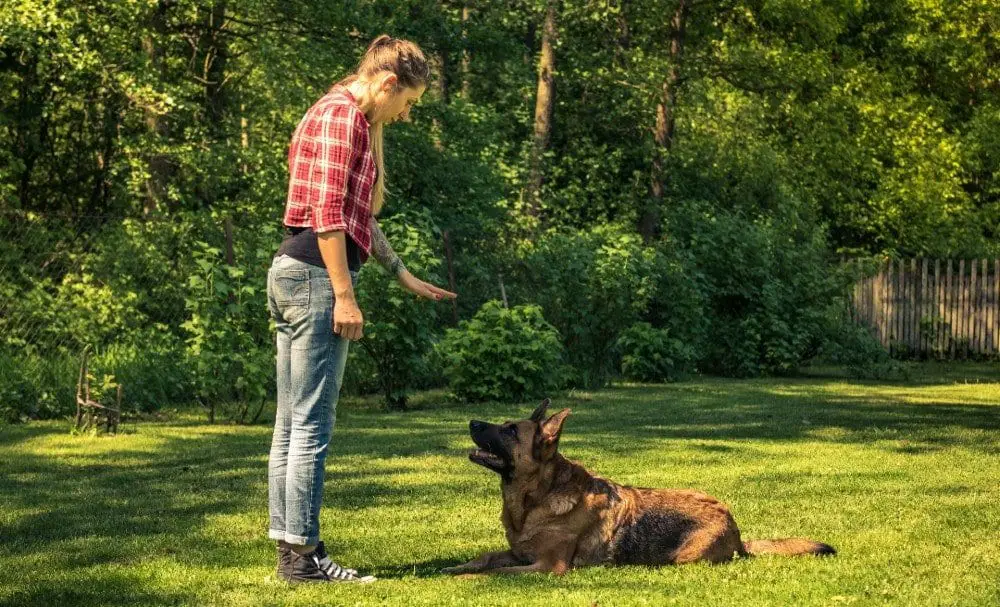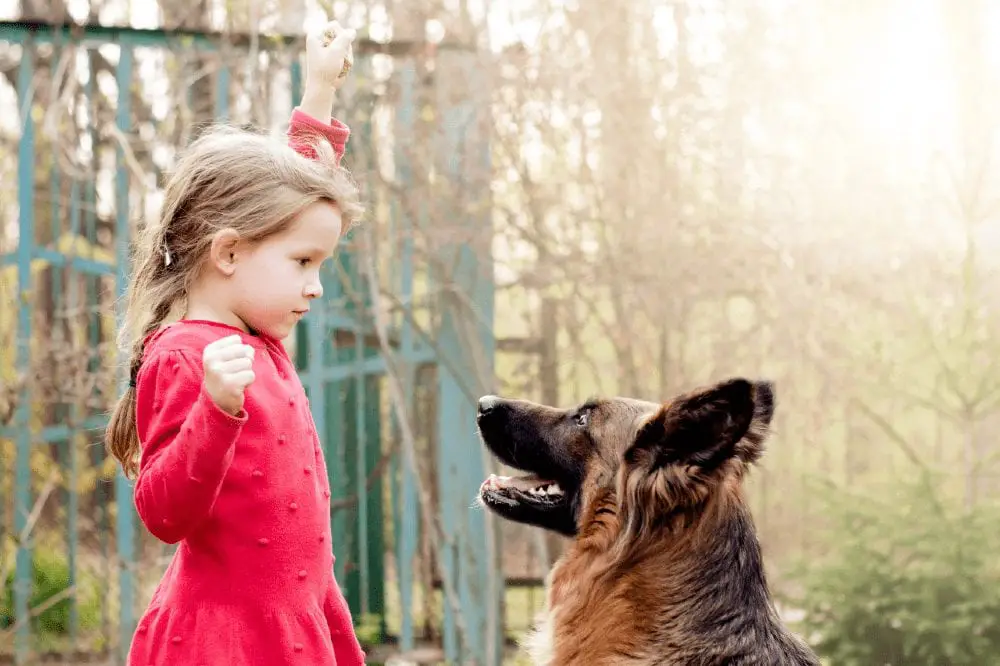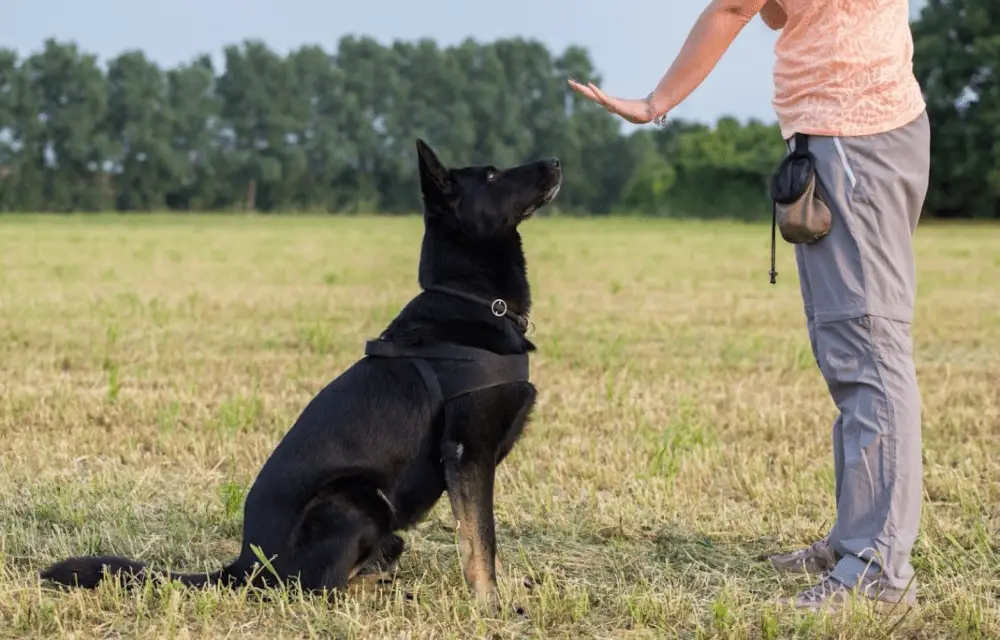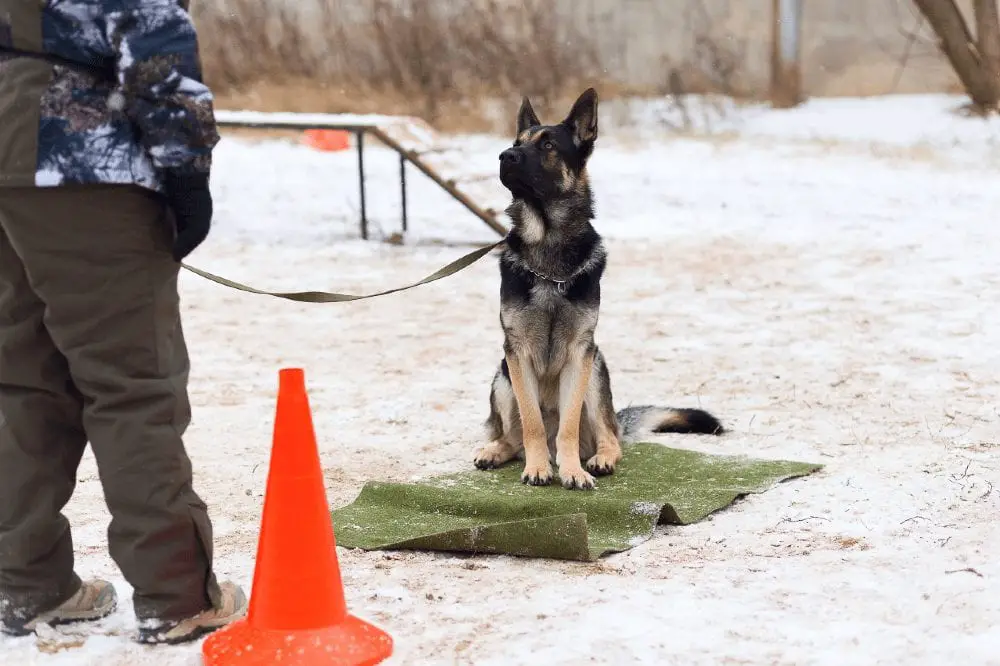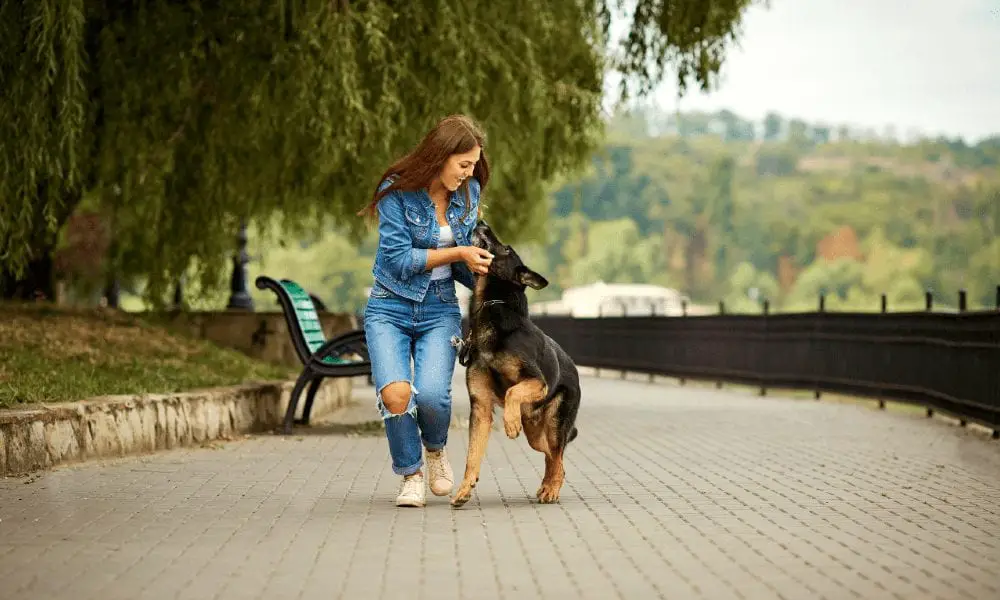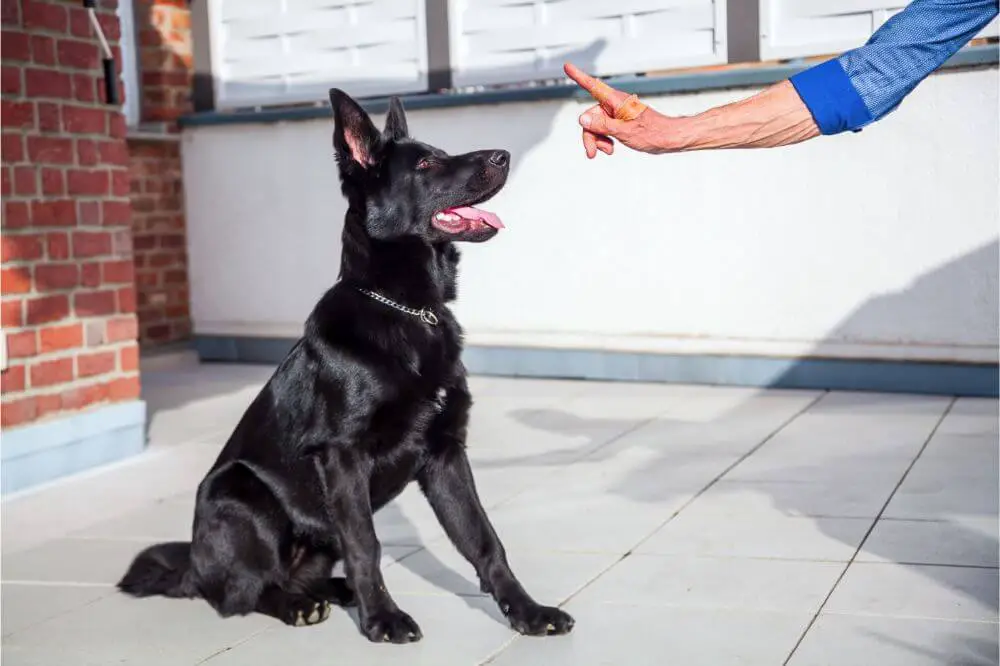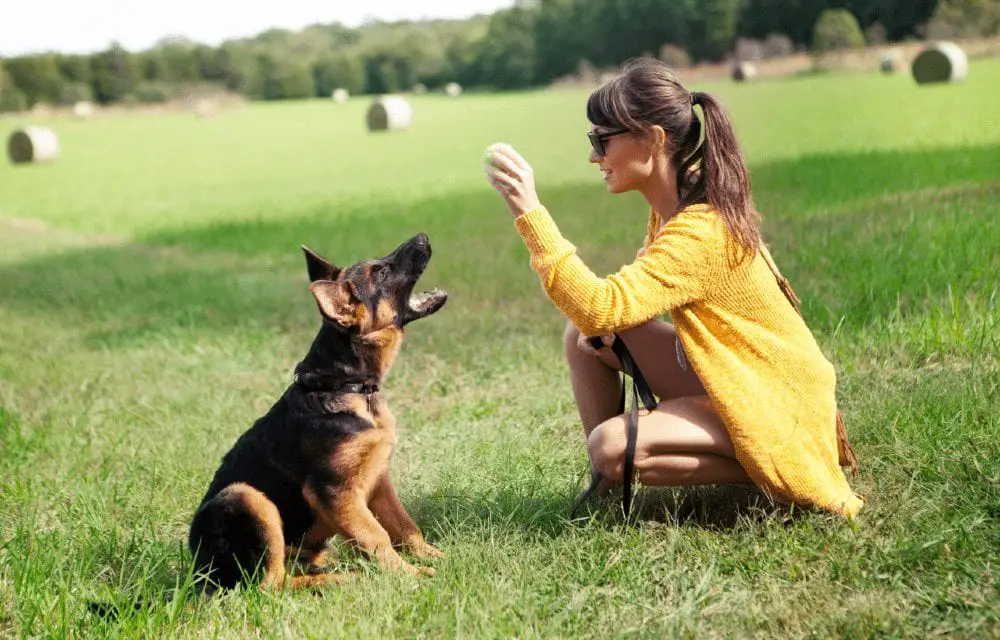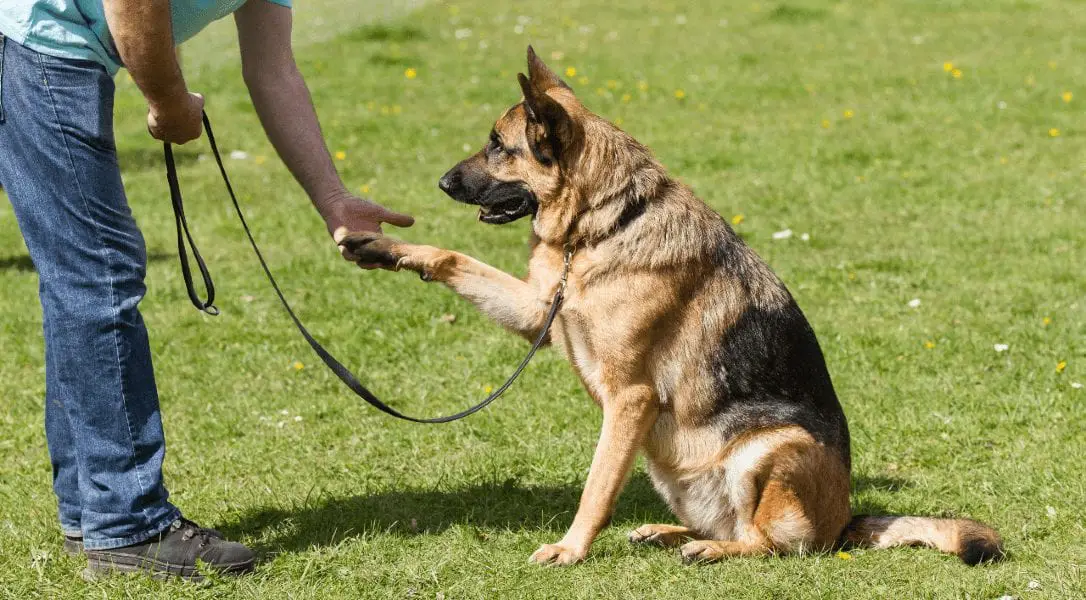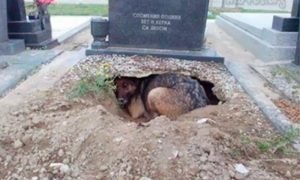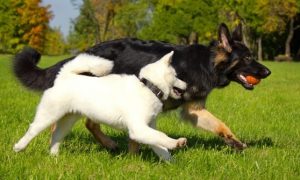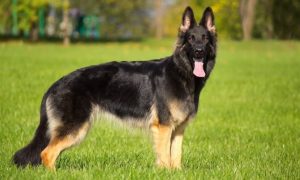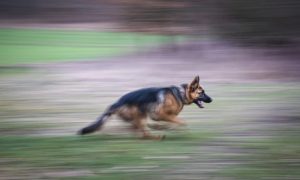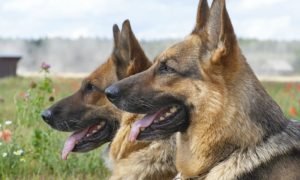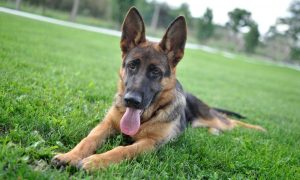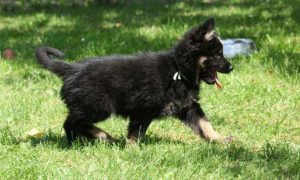German Shepherds are the ideal dog for owners who love training and the challenges and rewards associated with owning an intelligent working dog.
For maximum effectiveness, part of training should always include pairing a hand signal with a command.
Training your German Shepherd with hand signals is important for a variety of reasons:
- If you need to command your dog to do something specific, but there is a lot of background noise or distance between you, your dog can still understand what you want. This can be life-saving in the event of an emergency.
- Training your German Shepherd with hand signals is a way to maintain communication if they lose some or all of their hearing.
- There will be times that you cannot speak to address your dog, such as during a phone call. Training hand signals allows you to communicate with your dog in these scenarios without interrupting what you are doing.
- Since German Shepherds are very intelligent and need mental stimulation, training with hand signals is an excellent way to fulfill that need.
When deciding to train your German Shepherd with hand signals, refer to the following tips:
- As you train your dog these hand signals, be sure to always start each command with your arms relaxed at your sides, then clearly make the hand signal and pair it with the command, so your dog does not associate any other movement with the command.
- When training your German Shepherd with hand signals, the below are examples, but you may use whatever hand signal makes the most sense to you if you prefer a different signal.
20 Hand Signals to Train German Shepherds
1. Look
Teach your dog “look” by holding a treat between your first two fingers and moving it to your forehead. When your dog looks at you, say “look” and offer them the treat.
The motion of moving your first two fingers with the rest of your hand clenched in a fist toward your forward is the hand signal for this command.
2. Sit
Teach your dog “sit” by first showing your chosen hand signal for sit, such as a clenched fist parallel to your chest, saying “sit,” and holding a treat over their head.
When your dog sits flat on the ground, not in a position they or could quickly spring out of, but completely sits, repeat the hand signal and the command and reward with a treat and praise.
3. Down
Teach your dog “down” by holding your hand flat, palm to the ground, and bending your fingers down at the knuckles, like you are pressing your hand around an apple. Clearly say “down,” do the hand signal and reward with a treat.
4. Stay
Teach your dog “stay” by first having them sit, then clearly saying “stay,” and holding up your hand as you would motion to a driver to stop a car parallel to your chest.
Back away gradually, maintaining eye contact, the hand signal, and occasionally saying “stay.” Begin having your dog stay for a few seconds and gradually work your way up to longer periods of holding the command.
Your dog should hold the command even when they cannot see you; work up to stepping out of sight and having your dog hold the stay command.
Since this command is more difficult because dogs have an instinct to be by their owner’s side, high-value treats should be used when training the stay command.
5. Here
Teach your dog “here” by first having them sit, lay down, then stay, then say clearly in a positive, upbeat tone “here!” while making the hand signal for come.
To make the hand signal for here, hold your hand flat, palm up, and bending your fingers upwards, motioning your dog to come towards you similar to how you would direct the driver of a car to pull forward.
Since dogs love being with their owners, this command is usually picked up very quickly. Work on it without distractions until your dog fully understands it, then move up to working on it outdoors with distractions, as come is a very important command for dogs to respond to even with distractions.
6. Leave It
Leave it is a command that all dogs must be taught; it could prevent them from eating something poisonous.
To teach your dog “leave it,” you will need one of their favorite toys. Show them the toy and set it down, firmly say “leave it” and hold up your first three fingers, pressing your thumb onto your little finger across your palm.
The first time you begin teaching leave it, hold for five seconds then release your dog by saying “okay!” in a positive voice. Gradually work up to longer periods.
This command is important to teach with distractions as well, as your dog listening to the command in a variety of circumstances could save his or her life.
7. Drop It
Drop it is also a critical command to teach; dogs find gross things sometimes, you do not want to have to wrestle a dead animal from your dog’s mouth by hand!
Teach your dog “drop it” by getting their favorite toy in their mouth, then offering a high-value food item.
Clearly say “drop it!” and pair with the hand signal, which is holding your hand parallel to the ground, palm down, and moving in a swift motion downward like you are sweeping something off a surface to the ground.
Throw the treat on the ground, and when your dog drops the toy to get the treat, reward with praise.
8. Place
Teach your dog “place” by choosing an appealing target area, such as a blanket on the ground or their dog bed. Point to the area with your index finger and say “place” clearly.
If your dog puts their whole body, including all four paws, on the area, reward with a treat and verbal praise.
This command is great for mental stimulation, and it is easy to do while out and about. For example, while on a walk, have your dog place on a large rock or another surface.
9. No
Teaching your dog “no” requires catching them doing something they should not be, such as surfing the kitchen countertop for snacks.
When you catch your dog in the act, firmly say “no!” and hold a hand up, palm facing toward your dog with your fingers spread out, then clenching them into a fist and bringing it down to your side.
If your dog stops the unwanted behavior, praise them. If your dog was going after a high-value item, ensure that the treat they are rewarded with is also of high value.
10. Heel
Teach your dog “heel” by having your dog walk on your left side on a short leash.
If they begin walking faster than your pace and pulling ahead of you, apply pressure to the leash, make a sharp right-hand turn, and firmly say “heel.”
Pat your hip or leg to encourage your dog to walk beside you in a proper heel position. Praise your dog verbally, and treats can also be used.
Pressure on the leash is the non-verbal signal for your dog to fall into step alongside you.
11. Kennel Up
Teach your dog “kennel up” by pointing to your dog, then the kennel with your index finger and clearly saying “kennel up!”.
When your dog goes into the kennel, offer a high-value treat and praise.
12. Take It
Take it helps better facilitate games like fetch and is mentally enriching for your dog to learn.
Teach your dog “take it” by holding out a favorite toy and saying “take it!” in an upbeat voice. When your dog takes the toy, praise them.
Most of the time, this command will be used for a dog to take something from its owner, so holding an item towards your dog is generally the hand signal for this command.
If you want your dog to pick up something from the ground, pointing to it and saying “take it” is a good way to communicate the command. Most dogs will understand this clearly.
13. Wait
Teach your dog “wait” by first having them sit, then clearly saying “wait,” and holding up one finger with the rest of your fingers clenched in a fist, parallel to your chest.
When first starting this command, pairing it with something fun like a toy makes it easy to learn. For example, show your dog their favorite toy, have them sit, then say “wait,” show the hand signal, then throw the toy.
If this is a new command for your dog, count to five in your head initially, then say a release word such as “okay!” and point forward to indicate that they may go get the toy.
If your dog does not wait and runs after the toy, restart until they do not run forward without releasing them from the command.
As your dog learns this command, gradually increase the amount of wait time.
14. Go Potty
To teach your dog “go potty,” you will need high-value treats and work on this during every bathroom break.
When it is time to take your dog outside, clearly say, “go potty,” and make a fist, with your first two fingers together pointing down. When your dog goes potty, repeat the command and signal and offer a treat and lots of praise.
15. Lap
Teach your dog “lap” by sitting in an area where your dog is welcome to be, then patting your lap with both hands twice and saying “lap” clearly. Your dog will probably jump on your lap immediately, and you will reward them by petting and praising them.
Your dog will likely learn this command the most quickly.
16. Speak
Speak is an excellent way to offer your dog mental enrichment and can be a fun party trick.
Teach your dog “speak” by getting them to bark, usually most easily done with a toy during playtime. Tease up your dog with a toy, say “speak” clearly, and pair the command with the speak hand signal.
The speak hand signal is holding one of your hands with your palm parallel to the ground, with your thumb under your fingers. Open and close your hand like you are making your hand a talking mouth.
17. Quiet
After your dog has mastered the speak command, it’s time To teach your dog the “quiet” command.
First, command your dog to “speak,” then hold a finger to your lips, similar to how you would tell a person to be quiet and clearly say “quiet.”
When your dog stops speaking, reward with praise and a high-value treat.
18. Roll Over
Teach your dog “roll over” by having him or her first lay down, then saying “roll over” and holding your hand with your palm parallel to the ground, then flipping your hand so that your palm is up like you are flipping a burger.
You might need to use a treat in a circular motion to help your dog understand to roll onto one side, then their back, then finishing on their belly.
Make your dog roll over completely before rewarding and praising; otherwise, they will think rollover means roll onto your side.
19. Shake
Teaching your dog shake is a way to help them get more comfortable with their paws being handled, which makes nail trims easier for everyone.
Teach your dog “shake” by holding your hand out towards them as you would extend it to a human you intended to do a “low five” handshake with. When they put their paw on your hand, shake once and reward with a treat and praise.
If your dog does not already know shake, start by enclosing a treat in your fist and extending it towards them. Your dog will sniff, lick and paw at your hand to get the treat. When they use their paw, say “shake,” open your hand and immediately reward with the treat.
20. Touch
Touch is a way to get your dog’s attention and bring them to you.
Hold your hand parallel to the ground with your thumb side up, fingers flat, and point away from yourself. Put some peanut butter (but first check the label for xylitol) on your fingers to encourage your dog to smell them.
Teach your dog “touch” by saying “touch” clearly and holding your hand in the correct hand signal, then when your dog comes over and touches your fingers with their nose, praise them.
Conclusion
Training your German Shepherd Hand Signals is a way to maintain communication in emergencies and facilitate commands in everyday life.
As you work on training your German Shepherd to recognize hand signals, be sure to keep the sessions positive and short; work on them a little bit every day for consistency.
Before you know it, your German Shepherd will respond well to the hand signals you have chosen to teach them!
Want to train your dog in German? Click here for the most common German Training Commands.

